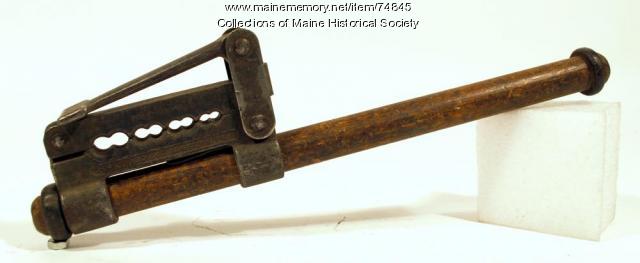Keywords: tool
Item 74845
Crimping-splicing tool, ca. 1935
Contributed by: Maine Historical Society Date: circa 1935 Media: Wood, galvanized iron
Item 6240
Dental pelican tool, Westbrook, ca. 1800
Contributed by: Maine Historical Society Date: circa 1800 Location: Westbrook Media: Steel, bone
Item 86709
Wharfingers Tool House, Union Wharf, Portland, 1924
Owner in 1924: Union Wharf Proprietors Use: Wharfingers Tool House
Item 86839
Tool House, Pocahontas Wharf, Portland, 1924
Owner in 1924: Pocahontas Fuel Company Incorporated Use: Tool House
Item 150728
Tool house for cemetery, Mechanic Falls, 1895
Contributed by: Maine Historical Society
Date: 1895
Location: Mechanic Falls
Client: Maple Grove Cemetary
Architect: George M. Coombs
This record contains 2 images.
Item 150713
Tool House for Maple Grove Cemetary, Mechanic Falls, 1902
Contributed by: Maine Historical Society Date: 1902 Location: Mechanic Falls Client: Maple Grove Cemetary Architect: Coombs and Gibbs Architects
Exhibit
Desserts have always been a special treat. For centuries, Mainers have enjoyed something sweet as a nice conclusion to a meal or celebrate a special occasion. But many things have changed over the years: how cooks learn to make desserts, what foods and tools were available, what was important to people.
Exhibit
Camden has been home to generations of fishermen, shipbuilders, sailmakers, and others who make their living through the sea. The lives of two Camden sailmakers, who were born nearly a century apart, became entwined at a small house on Limerock Street.
Site Page
Maine's Swedish Colony, July 23, 1870 - A Photo Essay of Hand Tools Found in the Swedish Colony
"A Photo Essay of Hand Tools Found in the Swedish Colony Click to view the photo essay Tools were a necessary part of every farmer's and…"
Site Page
Historic Hallowell - Industrial Recources
"Here are some of the tools they used followed with their descriptions: Auger, Caulking Mallet, Horsing Iron, Jerry Iron, Nog, Oker, Pitch Ladle…"
Story
Growing up on a potato and dairy farm
by Paula Woodworth
Life growing up and working on a potato and dairy farm was hard work but fun in Aroostook County.
Story
A Story in a Stick
by Jim Moulton
A story about dowsing for a well in Bowdoin
Lesson Plan
Maine's Beneficial Bugs: Insect Sculpture Upcycle/ Recycle S.T.E.A.M Challenge
Grade Level: 3-5, 6-8
Content Area: Science & Engineering, Visual & Performing Arts
In honor of Earth Day (or any day), Students use recycled, reused, and upcycled materials to create a sculpture of a beneficial insect that lives in the state of Maine. Students use the Engineer Design Process to develop their ideas. Students use the elements and principles to analyze their prototypes and utilize interpersonal skills during peer feedback protocol to accept and give constructive feedback.



















